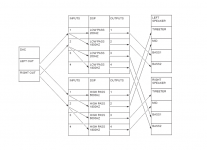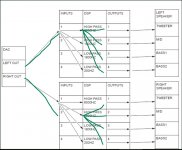Hi, everyone. First post here...
I am currently finishing the design of what i hope to be my 2.0 home theater speakers.
I have this down, so far: RSS265HF-8 in 3.5cuft ported enclosure tuned to 19Hz, another RSS265HF-8 in 1cuft sealed enclosure, sealed tweeter-mid combo (tweemid) Morel TM4055-8.
I already have the Dayton DSP 408, which i plan to use as a crossover: analog stereo in - split into "sub-bass", bass, mid and treble for left and right channels (mono bass with L-R delay correction), then feed the signal into 4 stereo amplifiers i already have.
Now... this is the setup for the testing and tweaking phase... I plan to make it pretty, which would mean hiding all those amps somehow.
I was browsing PA amps and ran into this - the t.amp quadro 500 dsp - a 4-channel amp with sufficient power and integrated DSP. The question is this - would there be any issue in using one of these for each speaker? I mean.. ignoring SQ issues with this particular amp, I am more worried about things blowing up, somehow.
Can the amp (or a typical amp, or any amp) handle such different loads on its channels? Is crosstalk an issue? Should I expect my tweeter to suddenly receive 100W worth of LFE and just go *poof*?
I am currently finishing the design of what i hope to be my 2.0 home theater speakers.
I have this down, so far: RSS265HF-8 in 3.5cuft ported enclosure tuned to 19Hz, another RSS265HF-8 in 1cuft sealed enclosure, sealed tweeter-mid combo (tweemid) Morel TM4055-8.
I already have the Dayton DSP 408, which i plan to use as a crossover: analog stereo in - split into "sub-bass", bass, mid and treble for left and right channels (mono bass with L-R delay correction), then feed the signal into 4 stereo amplifiers i already have.
Now... this is the setup for the testing and tweaking phase... I plan to make it pretty, which would mean hiding all those amps somehow.
I was browsing PA amps and ran into this - the t.amp quadro 500 dsp - a 4-channel amp with sufficient power and integrated DSP. The question is this - would there be any issue in using one of these for each speaker? I mean.. ignoring SQ issues with this particular amp, I am more worried about things blowing up, somehow.
Can the amp (or a typical amp, or any amp) handle such different loads on its channels? Is crosstalk an issue? Should I expect my tweeter to suddenly receive 100W worth of LFE and just go *poof*?
No, this isn't the way it works. An amp can potentially supply enough power to damage a tweeter, you just don't turn it up that far. Already the high frequency signal which has been crossed, is smaller than the low frequency section.
On the other hand, if you turn it on and it goes thump, you might have a problem. Or if you touch the input connectors while it is operating, or adjust your filters and they go high level etc.
On the other hand, if you turn it on and it goes thump, you might have a problem. Or if you touch the input connectors while it is operating, or adjust your filters and they go high level etc.
The second configuration is the preferred way, although both should function equally well. I personally prefer the second routing method, because this way LEFT and RIGHT are identical copies of each other, whereas the first configuration requires extra effort to manage.
Crosstalk is rarely a factor. However, if you do have issues with crosstalk, that would constitute a design flaw.
It is good practice to include a protective series capacitor with a tweeter to protect it from accidental low frequency signals.
Crosstalk is rarely a factor. However, if you do have issues with crosstalk, that would constitute a design flaw.
It is good practice to include a protective series capacitor with a tweeter to protect it from accidental low frequency signals.
Last edited:
I think I'm having trouble asking the question in a way that it will be understood.
I know this is ok: View attachment 917202
The question is... is this ok? View attachment 917203
If it is, I can alter the design a bit to fit each cabinet with a 1U rack, and make them "active" speakers...
Your second option, using a single amp for all 4 sections is the best way, in my experience. It's a more straightforward routing, with less likelihood of mixing up outputs.
Plus, it will provide more available power to the sub bass and bass. Multichannel amps draw from a common power supply, and only very expensive amps can usually deliver full rated power to all channels simultaneously.
So it's best not to make all the channels work so hard.
And different impedances across the channels doesn't matter.
One of the really nice thing about PA amps is the the lack of power on/off thumps. No worries there as far blowing the tweeter.
It doesn't take much experience to get good at not making drive level mistakes.
I routinely power and measure any new driver I'm working with, using amps having 1000 watts per channel.
This includes little guys like a single TC9, Morel tweeter, CD's, etc.
It's gets safe like driving a car... don't run off the road because you simply can't.
The compressor on each channel may be adjustable to a fast enough attack time, to give protection, ....it's worth looking into if you're at all nervous.
Last edited:
Thank you for your answers.
I will certainly remain open to making them "active" once they are tested, although I may keep the amps outboard.
This is the design so far:
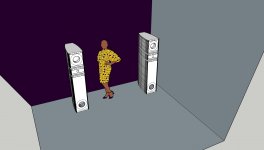
2 large speakers, composed of (3 each) separate cabinets for the drivers, as i said in the first post. Made of laminated 30mm mdf, CNC-routed. Port is down-firing, but this is accounted for (to the best of my abilities, hehe).
More (internal) views:
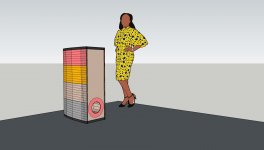
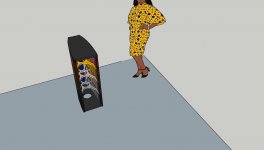
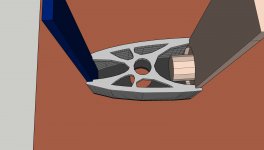
Sealed sub has plenty of bracing. Internal surfaces will receive "treatment" against standing waves, however irrelevant that may be for low frequencies.
WinISD simulation of both bass enclosures:
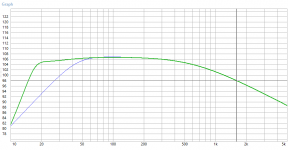
Tweeter+mid combo doesn't benefit from enclosure (sealed dome mid), but i want a separate box for it to allow for placement flexibility.
The question, again, is: any glaring flaws in the design? Routing starts tomorrow, then I can tweak some things but not a lot...
I will certainly remain open to making them "active" once they are tested, although I may keep the amps outboard.
This is the design so far:

2 large speakers, composed of (3 each) separate cabinets for the drivers, as i said in the first post. Made of laminated 30mm mdf, CNC-routed. Port is down-firing, but this is accounted for (to the best of my abilities, hehe).
More (internal) views:



Sealed sub has plenty of bracing. Internal surfaces will receive "treatment" against standing waves, however irrelevant that may be for low frequencies.
WinISD simulation of both bass enclosures:

Tweeter+mid combo doesn't benefit from enclosure (sealed dome mid), but i want a separate box for it to allow for placement flexibility.
The question, again, is: any glaring flaws in the design? Routing starts tomorrow, then I can tweak some things but not a lot...
It might be too noisy for home use. A high power output + mediocre signal to noise ratio means that the absolute noise level is higher than you might expect.I was browsing PA amps and ran into this - the t.amp quadro 500 dsp - a 4-channel amp with sufficient power and integrated DSP. The question is this - would there be any issue in using one of these for each speaker? I mean.. ignoring SQ issues with this particular amp, I am more worried about things blowing up, somehow.
Yes go for a xlr-dsp/filter instead. ..if you gonna run an analog vol control and xlr-amps.
Last edited:
- Home
- Loudspeakers
- Multi-Way
- Active 3.5-way speaker with active crossover?
